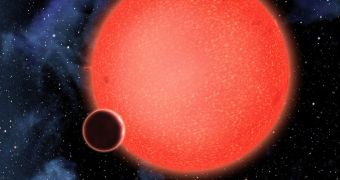Astronomers say that they were recently able to identify an entirely new type of extrasolar planet, which resembles none of the types we've seen before. While smaller than Uranus, the celestial body is much larger than Earth, but is also covered in water, for the most part.
In addition, its surface is covered by an extremely thick and steamy atmosphere, further amplifying the mystery of how this exoplanet came to form. The investigations team that analyzed the world was led by Harvard-Smithsonian Center for Astrophysics (CfA) scientist Zachory Berta.
Named GJ 1214b, the newly-found planet was first observed using the NASA/ESA Hubble Space Telescope, at a distance of about 40 light-years from Earth. It lies in the constellation of Ophiuchus (The Serpent Bearer).
The planet itself was discovered about 3 years ago, by the MEarth Project. That effort was led by astronomer David Charbonneau, who is also based at the CfA. The survey revealed that GJ 1214b was around 2.7 times larger and 7 times heavier than Earth.
Average temperatures on its surface reach 230 degrees Celsius (446 ºF), primarily because it orbits only 2 million kilometers (1.24 million miles) from the surface of its parent star, a red giant. One year on the surface of the planet lasts for about 38 hours.
Spectrometric analyses of the planet's atmosphere, conducted in 2010 using the Wide Field Camera 3 (WFC3) instrument aboard Hubble, revealed that GJ 1214b's wavelength spectrum was mostly clean, a finding that helped confirm the theory stating that the atmosphere is mostly made up of water vapor.
“GJ 1214b is like no planet we know of. A huge fraction of its mass is made up of water. We’re using Hubble to measure the infrared color of sunset on this world. The […] measurements really tip the balance in favor of a steamy atmosphere,” Berta says.
One of the most interesting aspects of this alien world is the fact that it may contain significantly more water than Earth does. It has a density of only 2 grams per cubic centimeters, whereas Earth has a density of 5.5 grams per cubic centimeter.
There are also some interesting implications of this discovery in physics. Investigators say that the internal structure of the exoplanet favors the development of high temperatures and extreme pressures.
These “would form exotic materials like ‘hot ice’ or ‘superfluid water’, substances that are completely alien to our everyday experience,” Berta explains. Details of the new investigation appear in the latest online issue of the Astrophysical Journal, and have also been accepted for the magazine's print edition.

 14 DAY TRIAL //
14 DAY TRIAL //